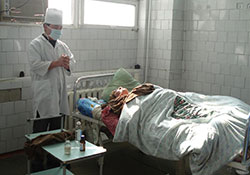Extreme cold and energy shortages create crisis in Tajikistan

WHO/Eugene Zheleznyakov
WHO/Europe activities in 2008
WHO/Europe made available emergency medical supplies for the people who were most at risk as Tajikistan struggled with an energy and cold emergency in the winter of 2007/2008. Night temperatures were as low as -22 ºC; with diminishing supplies of power, water, drugs and food, there was special concern for the health of the elderly, children and pregnant women.
In 2007/2008, Tajikistan experienced its harshest winter in three decades with average daytime temperatures at -15 ºC. Water lines either broke or froze, forcing families to rely on melted snow for drinking-water. A major hydroelectric power plant had been affected by falling water levels as rivers froze, threatening energy production, while energy supplies from neighbouring countries such as Uzbekistan had also been reduced. Many rural areas had access to just one or two hours of electricity a day. Wood being used as fuel doubled in price, putting it beyond the means of many people. Heavy snowfall blocked roads in some areas, cutting off or slowing access to critical medical services and markets. Subzero temperatures and water shortages continued throughout the winter.
Prolonged exposure to cold, the use of alternative heating devices at home (gas, kerosene, stoves with wood and charcoal), the lack of running water, and isolation or overcrowding of people harmed the health of the general population. The energy crisis also had a significant impact on already strained health care services, essential drugs and vaccine supplies and access to health care facilities. Vulnerable groups (including pregnant women, children, the elderly and the mentally disabled) were particularly at risk.
These poor living conditions resulted in a higher incidence of acute respiratory diseases, deteriorated hygiene standards, increased incidence of water-borne diseases, the worsening of chronic diseases and an increased incidence of preventable maternal and infant deaths, as well as unsafe deliveries.
Prolonged power supply disruptions were reported in more than 50% of health facilities in four major districts of the country – Kulyab, Rasht valley, Kurgan-Tube and Sogd oblast. The water supply was not available in more than 50% of the hospitals across the country due to power shortages and cold weather.
As part of the United Nations country team, WHO coordinated closely with other international organizations and the government to respond to the crisis.



